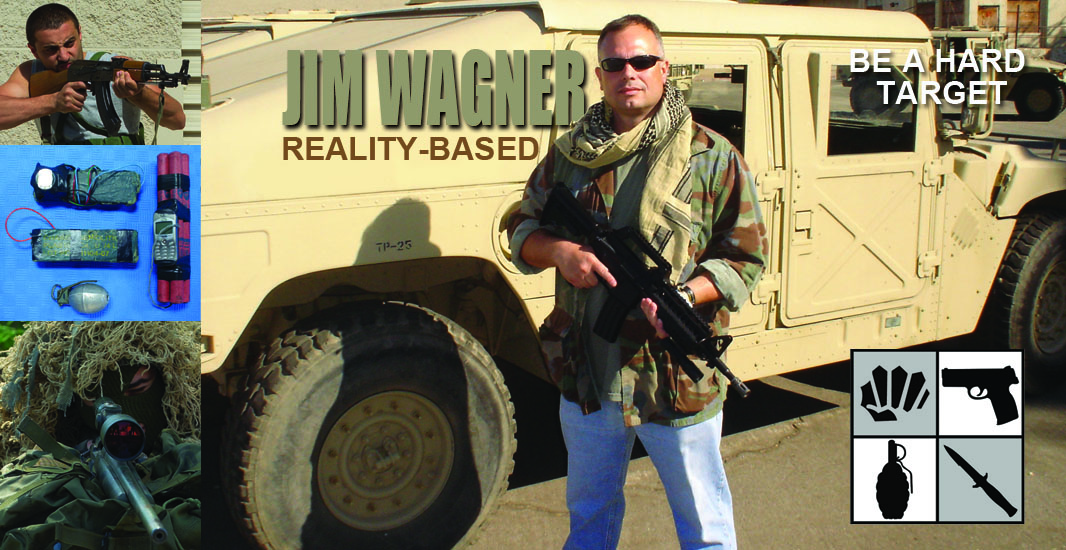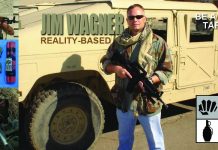With these hard economic times upon us, and no signs of letting up in the near future, there may be even more riots and flash mobs running through our streets.
A large segment of British society has been rotting away like a termite infested wooden support beam for years and everyone is wondering why the structure is collapsing. Of course I’m talking about the riots that took place on four apocalyptic nights between August 6th and 9th where thugs took to the streets all across England firebombing, looting, and terrorizing citizens in a new social media driven type of rioting called “flash mobs.” I’m just thankful that I wasn’t around to witness the destruction like I did in the Los Angeles riots of 1992 and the French riots of 2005. My soul is vexed when I witness that kind of senseless violence. People can try to explain away the actions of these “poor disenfranchised individuals,” but I find little sympathy with a young man carrying off a television set or destroying the livelihood of a small shop owner. That kind of uprising is rooted in selfishness.
I had just finished up my Reality-Based Personal Protection courses in Devon, England, teaching people how to survive modern crime and terrorism, and I took a few days off to enjoy the English coast. On July 29th, a week before the riots, I took a train from Dawlish, my starting point, and into London; into the Saint Pancras train station to be exact. I had to go into central London in order to catch the next train going through the Euro Tunnel and into Paris, France. On that Friday life in London seemed fairly normal on the surface; to most people anyway, but I knew from my many years of teaching in the United Kingdom that crime was getting worse and worse. After all, that was why I was there in the first place; to teach people how to survive crime and terrorism.
I made it to Paris without incident and started teaching my Level 1 courses on August 1st. Monday was Defensive Tactics, Tuesday was Ground Survival, Wednesday was Knife Survival, Thursday was Crime Survival, and Friday was Terrorism Survival. Of course Europe was still numb from the terrorist bombing of July 22nd that killed 8 people and shooting deaths of 69 victims in Oslo, Norway that same day by the hand of the same evil man. I ran a full scenario in my Terrorism Survival course in Paris based on the shooting spree of Anders Breivik, and I did that same scenario a week earlier in Paul Drury’s school in Dawlish, England.
With a job well done, that is to say a week of teaching the self-defense courses, I celebrated on the final evening with my French Director Julien Nodier and Reality-Based protege Christophe Besse at a quaint cafe. Christophe started the evening off by saying, “It’s a good thing you were in London last week and not this week.”
“Why?” I asked.
Christophe responded, “I saw on the news before coming here. There are big riots there.”
When I looked for myself later that evening, the infamous August 6th was well underway. I was shocked, but not surprised, to see the images on all of the French television stations showing the beginning of the riots. “Initial reports said that the police had fatally shot a man, a Mark Duggan, who had taken shots at them with a firearm in Tottenham in Greater London. Locals were reacting to the incident because the suspect was black, and the story dripped with racism from thereon out. When the second day brought more reports of even more intense riots, and then the third day, and then a fourth day where rioting had spread to cities all over England, people in continental Europe started saying, “What is going on over there?” By then the stories caught my full attention. The images coming out of that country looked like a war zone. It was obvious that more evil forces were driving the riots than the initial shooting.
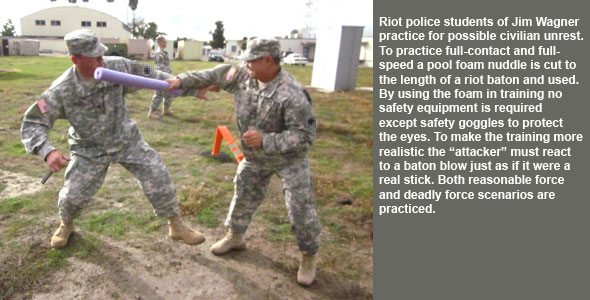
One of the biggest complaints stemming from the riots was that the police were unable to ensure order. Things had gotten so bad that a poll conducted by YouGov for the Sun newspaper showed that 33% of those polled wanted the police to use real bullets on rioters, and an overwhelming 77% wanted the army to be deployed. For a country that loathes guns those numbers are quite remarkable. Few police officers in the UK carry guns. Those are reserved for select units such as Trojan Teams or Flying Squads. The bottom line is that people were scared and wanted law and order restored. Citizens were fed up with seeing stores looted, rioters lobbing Molotov cocktails at the police, cars being set on fire and people having to shut themselves in holes like rabbits in order to avoid the random violence sweeping the streets. What made this incident worse, and more fluid than the police could handle in the beginning, was that the thugs used mobile phones to communicate with one another instantly. Text messaging to multiple contacts told the marauders where and when to assemble. This use of technology created the “flash mobs”.
So, outside of England, why are these riots important to the rest of us? Especially to those of us who want to learn how to protect loved ones and ourselves. The reason is evident for anyone who has their eyes at least half way open in the Western world, and who have the ability to read between the lines of the local and national news. The very problems simmering under the surface of English society is also simmering in North America, South America, and Europe; obviously in some places more than others. Because I teach police and military personnel all over the world I have the advantage of seeing the larger picture when it comes to regional crime and terrorism. When my police students in Italy tell me that violent crime is increasing, I believe them. When my Irish students say that Ireland is much more dangerous than it was ten years ago I have no reason to refute it. When Germans tell me that they don’t feel safe in certain German cities anymore I have to agree, for I have seen it with my own eyes. Then when I returned home to the United States I hear that there were some flash mob incidents in Philadelphia on July 29th the same day I was on a train bound for Paris.
Going back to my own country I can tell you that both the police and military are quietly getting prepared for possible large-scale riots. If the economic crisis continues, and there is every indication that it won’t end in the next year or two, and some economists predict it getting worse, people’s nerves will get rubbed even more raw than they are now. Of course, there are plenty of thugs who will mix with legitimate protesters and take over the mob just like what was done in England.
I’m not saying that things will spiral out of control, and there will be anarchy in the streets of Europe and America, but it is obvious that there will be hot spots flaring up. I doubt that unrest like that seen in several Arab countries this past year will be as bloody, or give rise to the overthrow of a few governments, as it has in North Africa and the Middle East. Those troubles stem from totalitarian regimes with human rights issues. However, a word to the wise should be noted, all of the Arab uprisings stem from economic disappointment. To deal with these problems the Syrian government slaughters their protesters, while the President of Iran has just pays off its citizens with large sums of cash generated by crude oil: you haven’t heard much complaining coming out of Iran lately, have you?
Now, to the self-defense issue on hand. On a purely tactical point of view, stay away from mass demonstrations that can turn violent. Staying away from potential trouble is always the wisest choice. However, if you feel a need to have your voice heard with the assembling of others then at least stay on the edges of the mob, preferably on the opposite end where the police have formed a line. Like any potentially hazardous situation, always be aware of your exits and escape routes. The last thing you want happening to you is a few hundred people stampeding over the top of you to get away from the police.
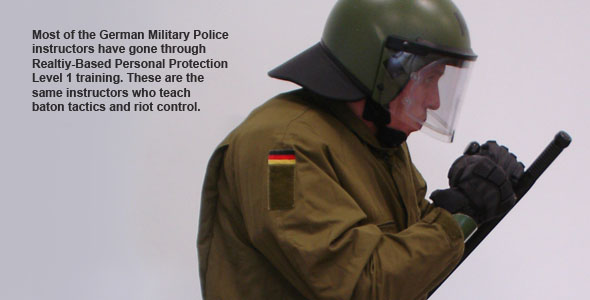
If you see someone in the crowd trying to agitate those around them in taking direct action against the “authority,” move away from that individual. You definitely do not want to be near “the heat source. Also, don’t forget, many times the police place undercover officers in the crowd acting like protestors to pinpoint those individuals who are inciting people to violence.
You also have to think about opposing view groups wanting to strike against the demonstrators you may be in the midst of. You still have to think, What if someone planted a bomb? Where would they most likely have it for maximum casualties? Or, What happens if a sniper opens up on the crowd? Do I have adequate cover I can get behind instantly? Or, What if some idiot starts spraying pepper spray in order to make the police look like they started the chaos? A lot of scary scenarios must be contemplated when you are a part of a large group of people demonstrating.
I’m not just giving you this advice with no experience in demonstrations or riots, but I’ve had some real-world experience that may help give you some more insight into a mob. I’ll start when I was a demonstrator myself. Yes, that’s right, I was in a crowd that was starting to stir up some trouble.
One time a friend and I were in Vancouver, Canada. This was sometime between 1992 and 1995 when the American military was bombing Serbian positions in the Balkans War. A huge group of people was protesting the American government, and my friend and I decided to blend into the demonstrators and get a few clandestine photos of mob mentality. We said to one another, “How violent can a group of Canadians be?” Obviously, we were not hockey fans. They can get pretty violent just like an other human beings.
My friend and I had enough sense to stay on the edges of the crowd, and we told ourselves that if the crowd started displaying any signs of violence we would extract ourselves out of it and go about our business elsewhere. Well, the mob started to move in a certain direction and we followed along; it was more like surge that carried us along with the massive tide of people. My friend and I even picked up a large Canadian flag some kid set down and we started waving it as we walked. We were really deep undercover then. We just wanted to get a feeling of the dynamics of a political protest, and nobody knew we were Americans.
The mob turned a corner and we soon realized the objective of their march. They wanted to confront the police in front of the French Consulate. Why, I did not know. Perhaps the French were in on the war as well. When my friend and I saw a wall of police waiting in front of the target building we told ourselves it was time to go. Unfortunately, you can’t just walk away or people would notice you, so we just slowed our pace, and when an alley came up on our right side we gave our flag to someone and ran for our lives. There was no way we were going to go along with a Canadian mob protesting the Americans by clashing with a police line in front of a French Consulate. To top it off, we were there to meet with some police units for some future training I was to give. Everything about that rapidly changing situation spelled stupidity and danger. Nonetheless, we were able to get out of the situation because of our tactics and preplanning. Now, this is a fun story, but the lessons I learned should be of interest to you.
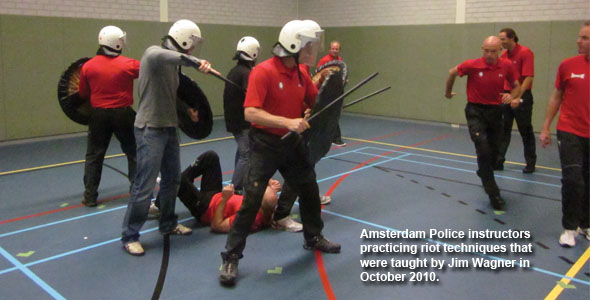
In the English riots many of the rioters would send text messages to their buddies and request participation at the next rally point. Some even suggested what stores they were going to loot. Now, I hope you don’t have loser friends or family members like this, but if you do, just keep in mind that the government can get a hold of these messages. If I knew someone inviting me to participate in their wonton lawless activities I’d write something back like, “Bob, don’t do it. It’s wrong and you are going to get yourself in trouble.” Not only will the police not connect me to the crime, because my stupid friend or family member made me a part of the paper trail, but the police will see that I tried to discourage the activity. It amazes me how people forget that everything sent over the Internet or phone lines is recorded and stored somewhere. It never goes away, like what you look up on search engines.
If you’re going to understand riots you also have to understand the authority’s involvement. After all, it’s the police who have to confront protestors and rioters. As a police officer I have also participated in two riots.
The first time I had to confront a hostile mob was when I was a patrol officer caught in the middle of a union workers dispute. We had four officers that were surrounded by approximately 50 to 60 angry workers who were on strike and refused to complete a shopping mall project called Triangle Square at the intersection of 19th Street and Newport Boulevard. Only two officers were available to go assist, basically “rescue,” these officers: Corporal Dan Hogue and me. Officer Hogue had been my Field Training Officer when I got out of the police academy, and he was an old salt, a Vietnam combat veteran, who didn’t take flak from anyone, and so I had great respect for him.
Dan and I pull up in our police cars and 20 men are waiting for us to prevent us from passing through and getting to our fellow officers who were surrounded by the larger group in the interior courtyard. I said to Dan, We’re going to need more back-up or approach from a different way.”
Dan just said, “Like Hell we are, follow me.”
He went straight for the middle of the pack and said to the first man standing in his way, “Move aside now!” with command authority and like Moses parting the Red Sea the 20 men made an opening and we passed through. I have to admit, I was extremely nervous walking in Dan’s wake, but I put on the same fierce game face that he had and prepared for the worse as we walked through with a determined purpose. For some unexplained reason nobody harassed us, and we mad it to the four officers. Additional uniforms seemed to be enough to bring tensions down and end the standoff peaceably.
To this day I still don’t agree with Dan’s tactics, but it worked. Had those 20 men turned against us it would have been one ugly fight, and with very little fighting space at that. Batons would have had to give way to shooting our way out, but fortunately it did not have to come to that, which brings up a very good learning point. Most times the police, especially when outnumbered, do not want a physical confrontation. However, if they start losing the battle, so to speak, most officers will resort to their firearms for self-preservation. There is nothing more frightening than to be surrounded by as hostile mob. It’s just like when you corner any animal, that animal will fight tooth and nail to survive.
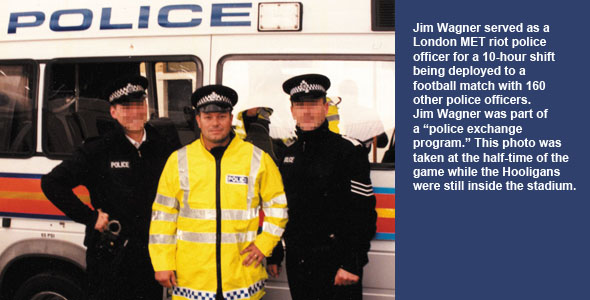
The second time I faced a riot as a police officer was when I was assigned to be a riot police officer. Like the first incident at Triangle Square, I was serving with the Costa Mesa Police Department just south of Los Angeles. In this second incident I had on my riot helmet and was armed with a baton, although we all maintained our gun belts just in case, and the ten of us marched to confront approximately 150 agitators. The odds were not in our favor, even though reinforcements were on their way from the neighboring city of Santa Ana. Our lieutenant insisted that we confront the agitators immediately, whereas I was more in favor of staying in front of the police station and setting up a perimeter; for it was believed that the crowd was going to march to our police station only 600 yards away. I can tell you from the police perspective that I didn’t like the idea of confronting that many people with so few police officers. Thank God for us the crowd did not feel like fighting when we showed up. We formed a line to funnel people down the street and they obeyed. Our mere presence, as small as it was, was enough to keep law and order.
The third experience as a police officer confronting a riotous mob was in London when I was a London Metropolitan riot police officer. That’s right, I was a British police officer, at least for one day anyway.
This goes back several years, 2002 I believe, when I was teaching a couple courses for London MET officers. After I had finished teaching, one of the sergeants asked me, “Jim, tomorrow there is a football match and a bunch of Hooligans are going to be there, and they will most likely cause trouble. We expect a riot. Would you like to come and observe?”
I was excited and answered, “Yes, of course, I’d love to come.”
I imagined a riot on some street somewhere, and them dropping me off on a safe corner and saying, “Right, you stay here and watch. We’ll pick you up when it’s over.” Of course, I would have been perfectly content with that. I had heard so much praise about British riot police officers and their effectiveness, and so I just wanted to pick up some good pointers for my own law enforcement education.
When I showed up bright and early at the police station the sergeant told me that I could come into the briefing and listen. It was great. The commander covered all the tactics that they were to use, and to my surprise I found out that they were going to have 160 police officers to deal with the potential incident. This was going to be much bigger than I originally thought.
In this morning briefing I found out that they were going to have riot police horses, air support, and a lot of vehicles. My blood was pumping realizing I was going to witness a lot more than I expected. I also thought to myself, “If this thing gets out of control I’ll just leave my corner and blend in with the crowd and find my way back to the police station.”
When the briefing was over the sergeant, my Reality-Based Personal Protection student and one of the best experts in England when it comes to surveillance techniques, came to me with a tactical vest, helmet, and baton cradled in his two arms. “Here Jim, these are for you.”
Now it occurred to my why this sergeant asked me the night before, “Do you have black tactical pants and black boots?” I did I wore them to the briefing.
I responded in disbelief, “What? You want me to wear these?”
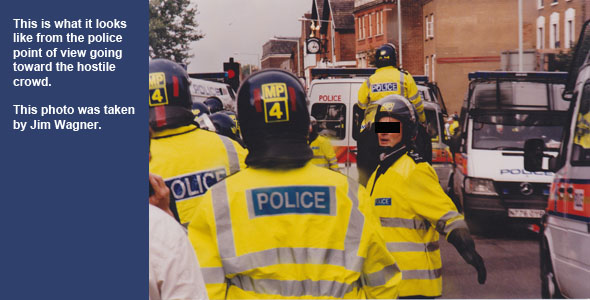
Yes, put them on now in the locker room. You’re going with us. As long as you don’t open your mouth and speak they will think you are one of us. There are one hundred and sixty officers going on this. Nobody is going to notice you. I looked like everyone else with my police haircut and cleaned shaven face, but my American accent was a dead giveaway.
Wow! I jumped at the chance and put on my kit. I was then assigned to a five-man riot team that was in a police van, or I think they called it a lorry. Either way I was to be a part of this event, good or bad.
When we got to the football stadium it was unbelievable. Helicopters circled in the air, men were mounted on a dozen horses, there were several different skirmish lines forming, and roaring noise rose from the circular stadium roof opening like noise escaping the great abyss.
There is rarely any trouble for spectators going into the stadium, it’s when they come out the trouble begins. Cops lined the street on both sides and they all seemed to know what groups to surround and who to escort to the train station a few blocks away.
At first everyone seemed to cooperate with the police only giving hard looks and a few finger gestures in defiance. Then as the forced march progressed there were a few bottles thrown here and there, and sometimes a police officer on horseback was seen clubbing a Hooligan below him who was trying to break the circle.
At one point things started getting rough and the team in my van deployed, running out into formation, and disappeared into the crowd. My last orders were, “Jim, stay with the driver. If anything happens you know what to do.” That’s when the adrenalin started kicking in. It was pure excitement up until that moment, but once again I saw the potential disaster that could befall me. As the van slowly moved down the street to keep the Hooligans in the center of the street, these angry men were walking right along side with us. Sometimes a fist or two would hit the side of the van door making me a little jumpy.
Just as I was wondering if the agitators next to us were going to make their move and I’d have to wrap some hands and arms that my try to get inside, our five-man team came back and took up a walking formation along side of us.
Although there was a little “stick time” by the police on the streets, it was less than I expected. The driver told me, “They don’t feel like fighting much today. This is good for us.”
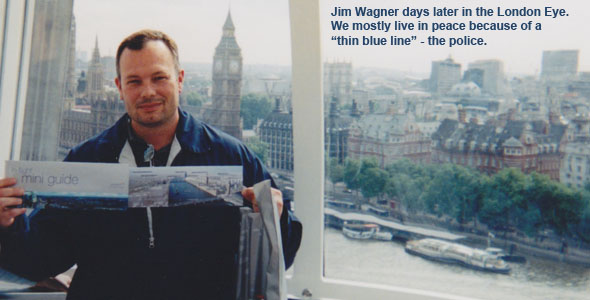
Eventually the police got whom they wanted into the train station and onto trains. The police even rode part of the way on the trains to make sure the troublemakers got completely out of London. When it was all over I had worked a complete 10-hour shift, and could honestly say that I worked one full day as a British riot police officer. There was one close call when my “cover” was blown during the actual football match when I came face to face with the highest-ranking police officer running the show, but that story is for another time; quite interesting also.
I bring up this last story because I not only trained London MET riot police officers, but I had the opportunity to work with them in an actual riot situation. I can say first hand that these men and women were the most professional riot police I had ever seen. They were far more professional when it came to controlling a crowd than my police department back home. “I imagine that not much has changed in the last few years, and I would venture to say that the police officers handling this latest English riots August 6 to 9, in London anyway, were just as professional. Plus, like any good police officers, they have learned from their latest mistakes dealing with the new phenomena of flash mobs and are coming up with new strategies and tactics and will be training up their line officers in the next several months. The citizens may complain about the police and their response, but it is worlds better than facing the Syrian or Iranian police.” We are fortunate in the fact that we hold our Western police responsible for their actions.
Today as a military police officer my unit has to maintain its riot control skills. Several months ago I had to teach a riot baton course to my fellow soldiers, and this included simulating a hostile civilian crowd we had to clear. Last year I taught a police baton course to the Amsterdam-Amstelland Police Training Center, which is part the current course curriculum to be taught to 3,000 police officers for this year.
I am by no means a riot “expert,” but I’ve had the opportunity to be on both sides of the fence when it comes to demonstrations and riots. With these hard economic times upon us, and no signs of letting up in the near future, there may be even more riots and flash mobs running through our streets. As such, it’s not a bad idea to have a little training on the subject. At minimum, talk to your family, friends, and co-workers on what action you would take if a mob is heading in your direction, or what to do if you find yourself in the middle of it. A lot of people protecting their stores and property in England found themselves in a very dangerous situation that they would have never imagined on August 5th; a day before the terrible riots. Don’t be caught unprepared.
Be A Hard Target.

